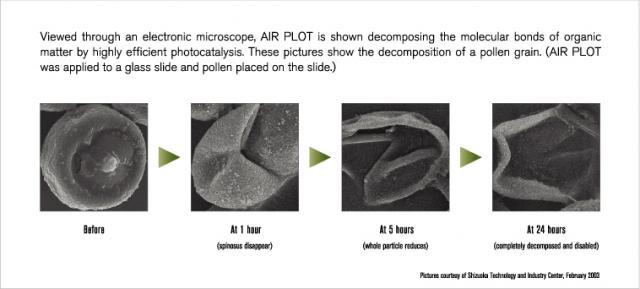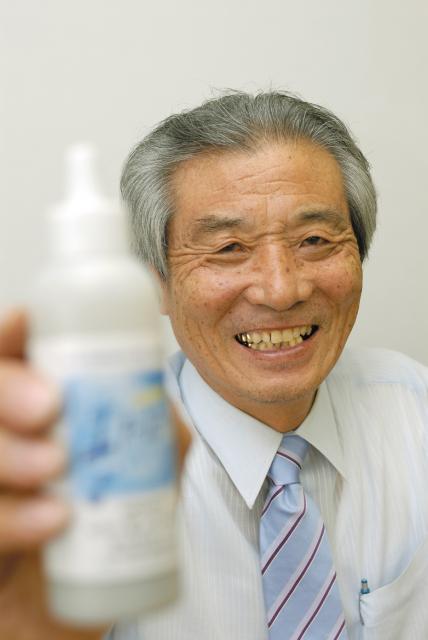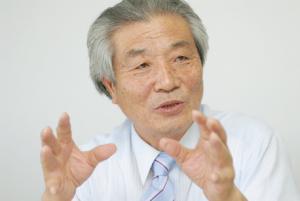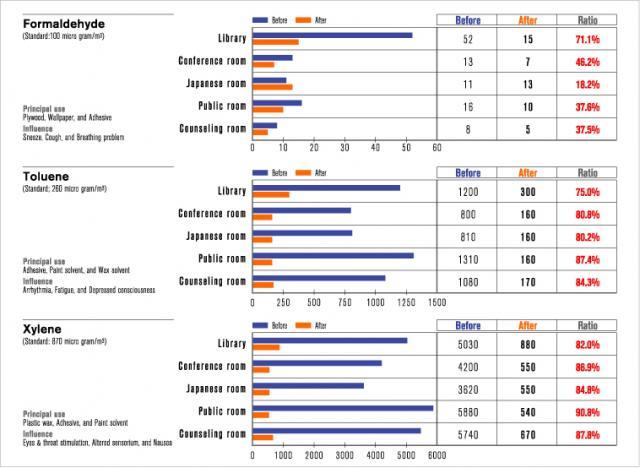The Hay Fever Man
Photocatalysts do more than clean windows and toilets
By Jack Beazley
Like this writer’s own 9-year old daughter, many kids in Japan suffer from hay fever or related allergies such as asthma. Every spring and sometimes in the fall as well, their eyes go red and itchy, their mucous membranes swell up. Each day starts with a sore throat and runny nose, not to mention, on really bad days, the pounding headaches. As parents, we can’t help feeling slightly helpless when hay fever hits (“kafunsho” in Japanese), and dream of finding a solution to the problem.
Tokyo—the developed world’s allergy capital
Japan, and Tokyo in particular, has one of the highest levels of hay fever and related allergy incidences in the world. As the affliction started to become prevalent in the 1970s and 80s, it was initially thought to be caused by general air pollution, but recent studies have proven that more than 60% of cases here in Japan are directly attributable to the excess of Japanese Cedar (“sugi”) trees planted around the country, and in volume on the outskirts of Tokyo. They were planted in the millions in the 1950’s and 60’s, to serve as a convenient timber source. Now around that same number are 40-50 years old, at the peak of their lifecycle, collectively pumping out about 1,800 to 2,000 of pollen per square centimeter each spring, equaling tons of pollen per acre.
The situation in Tokyo is in fact so bad it is estimated that at least 20% of the adult population suffers from hay fever. In the spring of 2005, the matter came to a head when the pollen count increased 4,200% over the previous year, due to a dry hot summer that preceeding year. Even Governor Shintaro Ishihara came down with it, and as a consequence, has initiated a program to reduce the number of pollen bearing Sugi by replacing them with a new low-pollen variety over the next 10 years. Some interesting statistics on past and projected future pollen counts can be found on the Kafun home page produced by the Tokyo Metropolitan Government.
www.fukushihoken.metro.tokyo.jp/kanho/kafun/index.html
Hay Fever is big business. Given that the majority of pollen allergy sufferers are aged between 30-60 years—the prime working age—it has both negative and positive real effects on the Japanese economy. On the debit side, according to an estimate by the Dai-ichi Life Research Institute, employee absenteeism and lowered productivity resulted in a JPY380bn (US$3.3bn) drop in GDP for the first quarter of 2005. Perversely, on the credit side, DLR reckons the market for hay-fever prevention products and medicines is worth JPY750bn (US$6.52bn). The biggest selling items are eye drops and face masks, which highlights the lack of effectiveness of other remedies. DLR notes, however, that the large number of people staying indoors probably also impacted revenues in the leisure and restaurant industries. In the first quarter of 2006, the pollen counts were almost back to normal levels, thanks to wetter weather, and DLR says that the nation’s GDP for March-April recovered by about JPY229.4bn (US$1.99bn) as a result.
Physical distress
While at least to some extent adults understand what’s going on, it is the children who probably suffer the most, as in the case of our 9-year old daughter. In March 2006, a survey by Rohto Pharmaceutical found that just over 30.2% of children under the age of 16 have hay fever. It is generally accepted that there is a causal effect between hay fever and asthma, with pollen, dust, mites, and other matter being the major points of blame. There have also been some studies in the last ten years that connect asthma to atopy (skin afflictions), through the inter-leukin-4 (IL-4) gene. Thus, controlling hay fever may be more important than just bringing sore eyes and a runny nose under control.
The mechanism of sinus-based allergies such as hay fever works as follows. The immune system recognizes an allergen in the environment, such as Sugi pollen, and produces immunog-lobulin E (IgE) antibodies. These antibodies are unique in that they signal the immune system to release hista-mine. While histamine is a normal compound found in body cells, in an allergic reaction it circulates through the bloodstream and constricts the small muscles around air passages in the lungs (inducing wheezing or asthma), increases the flow of mucus, and causes smaller blood vessels to contract and pass fluid into tissues. Coughing and sneezing is the body’s way of trying to expel the allergens from the air passages, while the difficulty of breathing with asthma comes about from the windpipe muscles constricting.
Our search to find something to help treat our daughter has taken us to pills, to plasma air conditioners, to living elsewhere temporarily, and finally to photocatalysts. While all of these things can bring about some relief, it is the photocatalysts which are most interesting—primarily because they are odorless, convenient, and recently, effective.
The world of Titanium Oxide
Photocatalysts are an interesting phenomenon of physics, and an area of materials science where the Japanese are literally a decade ahead of the rest of the world—in terms of patents, production, and adoption in buildings. The photocatalytic action of Titanimum Oxide (TiO2) particles was discovered in 1967 by a graduate student of the University of Tokyo (“Todai”), named Akira Fujishima. Together with his professor, Kenichi Honda, they investigated the self-cleaning and antibacterial properties of the anatase form of the compound. Their discovery was that under the presence of ultraviolet light, TiO2 can break down and render harmless airborne pollutants and organic matter such as mold and bacteria.
They caused an international sensation when they published their findings. The properties became known as the “Honda-Fujishima” effect, and in cooperation with TOTO Limited, Japan’s largest sanitary ceramics products manufacturer, the technology was commercialized. This was a smart move for TOTO, which today owns four basic patents related to photocatalysts. The business from IP licensing alone will be worth JPY1bn (US$8.69m) to the company in 2006, consisting mainly of its photocatalytic process provided to 80 licensees globally. Based on projected increases in usage of photocatalytic technology in the next 5 years, TOTO can expect this highly profitable revenue to increase at least five-fold.
The first Photocatalytic products were self-cleaning, non-yellowing white building tiles, released in 1994 and were well received by construction firms and the public. The tiles relied as much on Photocatalyst’s hydrophilic properties as they did on oxidation of organic matter. Apparently, water-hitting Photocatalyst is turned into a thin film, which has two actions: first it washes the building clean of attracted NOx and other particulates in the air, and second the water evaporates more efficiently, thus cooling the building on a hot day. One researcher has quantified the effect of the cleaning properties of Photocatalyst used in cladding on the Mitsubishi-owned Marunouchi Building in front of Tokyo Station. He states that the building provides the same air cleaning function as 200 poplar trees.
Today, thanks to improved antibacterial properties, Photocatalyst appears in such diverse products as air-purification systems, odor-fighting refrigerators and ovens, self-cleaning windows, streetlights, road mirrors, anti-fogging mirrors, medical devices and even a formaldehyde-busting wallpaper! Readers may recall that formaldehyde is one of the suspected causes of sick house syndrome. The overall market in Japan in 2003 for Photocatalystic products was estimated to be around JPY40bn (US$347m), for Europe JPY15bn (US$130m), and for the USA just JPY2.3bn (US$20m). Expectations are that the Japanese market alone will grow to more than JPY1trn (US$869m) by 2010.
But it could be better
With all the great properties claimed for TiO2, you would think that the compound would be incorporated into pretty much every home appliance, window, and building cladding product available on the market today. However, there is a hitch as to how well TiO2 works, and that is you need to have both intense UV and water to flush the surface, otherwise the compound becomes less effective in real life than in the lab over a period of time. In addition, it is known that the catalytic action of TiO2 can be improved by adding other elements and compounds. Among these are gold, silver, copper, silica, and aluminum bound in different combinations to TiO2.
These pairings are the name of the commercialization game. For example, when TiO2 is combined with silver or copper, the resulting compound is highly resistant to bacteria, so it has been used on hospital and clinic floors. Domestically, this market was worth JPY8bn (US$69.56m) in fiscal 2002. As can be expected, TiO2 applications currently under development include self-sterilizing medical instruments, and even direct application to kill cancer tumors.
The Zen World solution
Among the reported 2,000 Japanese companies researching TiO2 products, the 800lb gorilla has been TOTO. However, a new player with an exciting technology breakthrough in photo-catalysts has recently hit the market— Nobuyuki Matsui of ZEN WORLD Company.
Matsui is a Shizuoka-based amusement industry businessman who also happens to be interested in using photocatalysis to reduce the symptoms of hay fever and other environment-related allergies. After conducting some personal experiments with commer-cially available photocatalytic products, he found that although they had some of the advertised antimicrobial effect, the strength and duration of that effect was less than is necessary to get the job done if the product uses natural light, and now electrical power. He also questioned why TiO2 couldn’t work at night, requiring as it does a high level of UV light to work.
Thus, in May 2005, at a photo-catalytic event in Nagoya, Professor Emeritus Toshio Yuta, currently at Hokkaido University approached Matsui. The Professor proposed to Matsui that they look for an additive to TiO2 to improve its catalytic action. They both agreed, and they put together a team of Japanese and foreign researchers to investigate. By April 2006, the research officially started, with Professor Bunsho Ohtani, currently head of the Catalytic Reaction Chemistry Laboratory at Hokkaido University, showing results with the development of a platinum-TiO2 compound. Far more reactive, this compound has also shown to be safer to use and more environmentally friendly. An agreement was made to license the technology, and ZEN WORLD had its first photocatalytic product.
How well does the addition of platinum work? Matsui likes to show a lab photo of a glass of water treated with AIR PLOT in a diagonal slice and exposed to UV light. Amazingly, the portion coated with AIR PLOT is alive with O2 and H2 bubbles, while the untreated portion is still. Matsui notes with satisfaction, “You don’t get this kind of reaction with a TiO2 coating only—you need platinum to get this.” OK, point made.
AIR PLOT – commercializing PtTiO2
As mentioned previously, the allergens commonly present in an urban dwelling that can set off an allergic reaction in the human immune system are pollen, animal waste, dust, mold spores, and mites. There are two main natural ways for these allergens to enter the body— by way of food and liquids or by air. When food is ingested, any harmful elements are generally eliminated by the blood stream through the liver. However, in breathing allergens, since the air gets taken directly into the lungs and from there into the blood stream, there is no point of detoxification—just the filtering offered by the lungs themselves. Given that the average adult consumes about 20kg (44lb) of air daily, the body must combat an almost unending assault of airborne bacteria—bacteria that has ample opportunity to infect and affect the body.
 Decomposition of a Pollen Grain
Decomposition of a Pollen Grain
Thus, Matsui decided to apply his new photocatalysis product to cleansing the air. Furthermore, since a UV light source is the most effective way of activating a Pt-TiO2 surface, he decided that the product should be something that could be applied directly to the windows of a sufferer’s room—particularly the bed room and living-kitchen areas, since most individuals spend a lot of time in these parts of the house. Initially he considered producing an actual treated window glass product, but realized that this would be too expensive and consumer take-up too slow. Instead he came up with an ingenious liquid solution of active ingredients with a durable binder, all in the one bottle.
The product is called AIR PLOT and when applied to a window, will zap any allergens that come in contact with it, thus cleaning the air in the room. AIR PLOT was released at the end of 2004 after 5 intensive years of research and development. It is innovative not only because it contains the pro-catalyst element Platinum, but also because it has an inorganic binder which is unaffected by activated TiO2, even after 4-5 years.
AIR PLOT is a kit that consists of an 80cc bottle, the contents of which look milky white, and some cleaning and applicator tools. Matsui showed us how it is easily applied to a window with a type of squeegee and that after buffing it has none of the filmy appearance of regular TiO2 solutions otherwise available on the market. An application of AIR PLOT apparently lasts at full strength for about 3-4 years. A standard package costs JPY52,000 and the tester JPY23,000. The key to getting maximum effective-ness from AIR PLOT is not to use too much. TiO2 needs a high surface-to-air ratio, which is achieved when spread thinly and evenly.
The results from Matsui’s compound are well documented and he has had guest appearances on national TV (NHK) and the local press. AIR PLOT is proven to remove allergens that can cause hay fever, atopic dermatitis, asthma, and sick house syndrome. Matsui has lab and case studies to prove his claims. See the lab photos on previous page to appreciate the effect Pt-TiO2 has on unwanted organisms. Pollen particles break down after just an hour, mite feces break up after about 12 hours, and tobacco smells dissipate by 60% in just over 90 minutes.
Matsui’s pitch when introducing his product is to first explain the mechanics of photocatalysts, so that people can educate themselves that this bottle of innocuous liquid is actually something of value! As he explains it, “When a photocatalytic compound absorbs ultraviolet rays (UV) either from sun or fluorescent light, it forms activated oxygen which is strong enough to oxidize and decompose organic matter, odors, and unwanted bacteria. I liken the process to photosynthesis, whereby the chlorophyll captures sunlight to turn water and carbon dioxide into oxygen and glucose.”
Matsui says that the main benefits of AIR PLOT’s photocatalysis are:
1. Air purification: AIR PLOT eliminates harmful airborne matter such as NOx, SOx, and formaldehyde.
2. Deodorization: AIR PLOT eliminates Volatile Organic Compounds (VOCs), such as formaldehyde, toluene, xylene and paradichlorobenzene, tobacco odors, NOx fumes, urine and fecal odors, and gasoline smells.
3. Water purification: AIR PLOT assists with the decomposition and removal of water contaminants such as tetrach-loroethylenes and trichloroe-thylenes
4. ANTI action: AIR PLOT prevents the accumulation and growth of bacteria and mold—especially in hot and humid rooms such as bathrooms.
Okitsu Junior High case study
Matsui has done a number of tests in live locations already, including old folks’ homes and hospitals. However, since sick building syndrome is as much a problem overseas as it is in Japan, and hay fever is more dependent on localized conditions, let’s look at a case of treating sick buildings at the Okitsu Junior High School in Shizuoka Prefecture.
In 2002, the school commissioned the Sugimoto Construction Company to build several new buildings, consisting of a library, conference room, Japanese-style room, public reception area, and a counseling room. Sugimoto used standard techniques and mate-rials, however, the building was failed in an acceptance test by the Shimizu City Board of Education. The Board said that the level of VOCs such as formaldehyde, toluene, and xylene were too high and presented a health hazard.
The school debated whether to rebuild or refit the buildings, when Sugimoto Construction Company, which is in charge of new construction at the school, decided to contact ZEN WORLD. After hearing about his effective remedy, they contracted him to treat the windowpanes of the affected buildings. The treatment was completed in January of 2003, and the Board of Education testing contractors, Tobu Company Limited, came back in early that February. The second inspection passed with flying colors and it was officially recorded that the level of VOCs complied with Board health and hygiene standards. The results of the measurements made by Tobu are given in the following charts.
Where to from here?
Since mid-2005, Matsui has been marketing the AIR PLOT kits and praising their benefits. While initial take up was slow, due to the need to educate people about both the medicine of hay fever and the physics of photocatalysis, business is now starting to pick up. As this article was being written, he has entered into negotiations with several major car manufacturers to produce VOC-absorbing products that can be placed into new cars—which of course reek of chemicals when they are first made. Large volumes are being discussed, and clearly the carmakers are thinking to the future when some-one somewhere tries to draw parallels between sick houses and sick cars.
Matsui is also enjoying early acceptance by asthma and atopy self-help groups who see his solution as both effective and safe. With these groups, “kuchi-komi” (word-of-mouth), endorsements are all-important and sales are starting to climb as early users start to experience the benefits of having a year of reduced or no symptoms of hay fever. This author will certainly be trying out his AIR PLOT kit next spring, starting with our 9-year-old’s bedroom. TiO2-based products are already tested as safe by the USA’s Food and Drug Administration; indeed it is used as a whitener in toothpaste and filler in various foods, so this is reassuring.
Matsui is now interested in licensing and distributing AIR PLOT inter-nationally and invites enquiries from readers overseas. An added point of attractiveness, Zen World was also awarded an international patent on the system in October, 2006. If you’re in Japan and you or a member of your family suffers from hay fever, then you can contact the Shizuoka Sales Office to buy a tester package, or a full kit. JI
Contact details
ZEN WORLD Company.
President: Nobuyuki Matsui
3-21 Toro 6 chome Suruga-ku Sizuoka-si Sizuoka 422-8033
Tel: 054-654-5111
Email: zen@zen-world.co.jp
Web: www.zen-world.co.jp









Comments
gordman (not verified)
December 7, 2007 - 01:43
Permalink
This is an interesting
This is an interesting review at the first sight, it's hard to come with a relevant comment now that I am dizzy after reading so many biological terms. I think the secret for a good health and for a good life is having the perfect immune system. I guess not many of us can be proud with that.
Discount Vitamins (not verified)
January 4, 2008 - 20:54
Permalink
Allergy
Allergies are so common these days because of the pollution people develop them like i found out i am allergic to bee stings even if i was stinged before by bees only this summer i developed an allergy reaction and almost died